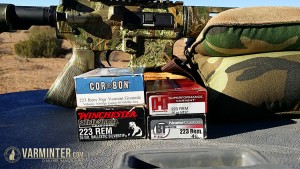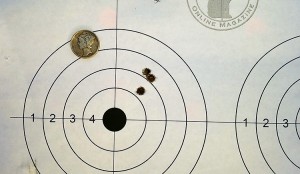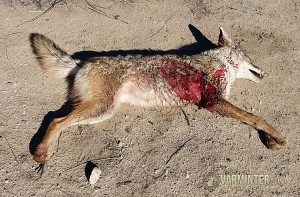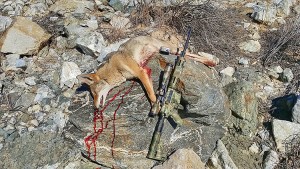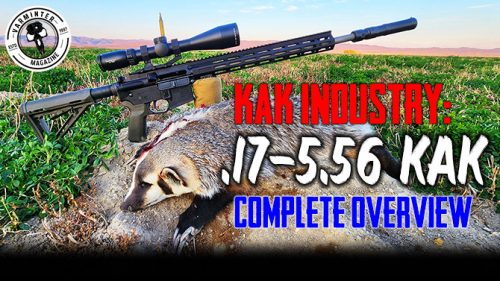As promised, one of the subjects we will be covering in 2016, is lead free ammunition for varminters. I am doing this, because lead free ammunition has become very important to my current home state’s (California) hunters. Thankfully, I am due to leave California later this year, but I will continue to cover lead free ammunition as they get closer to going completely lead free in a few years. This particular article is going to cover a lead free .223 coyote hunt and range report. We have been using these rounds for most of 2015, so we will do a more thorough review on each round covered here, at a future date.
Click Below to Watch The Video Portion of This Report:
The day started with me headed out to the range with my Remington R15 rifle in .223. The plan was to complete my range report, then do some predator calling in the current lead free zone of California. The ammunition I was testing consisted of the following manufacturers/bullets/weights:
Cor-Bon 36 grain Varmint Grenade
Winchester 35 grain Ballistic SilverTip
Hornady 35 grain NTX
Nosler 40 grain lead-free Ballistic Tip
My custom targets were set-up at 100 yards, with a 1/2″ bullseye. I was using my Nikon 4-12 x 40mm Coyote Special in Max-1 BDC, which I began using in the 2014/2015 season for predator calling, and some varmint hunting. I always switch scopes during the spring varmint season, but will switch back before the end of summer, so I can shoot smaller varmints with it before predator season rolls around. The Remington R15 is a very accurate rifle, rivaling some of the bolt-action rifles available today.
Range Results:
With each brand of ammunition, I shot a handful of 3-shot groups and had consistent groups from all the ammunition. Typically, I would shoot 5-shot groups, but due to time constraints, and past groups shot, I went with 3-shot groups on this trip. These are pictures of the average group for each brand (the space between the lines is 1/2″).
Cor-Bon 36 grain Varmint Grenade – 3-Shot Group – 100 Yards
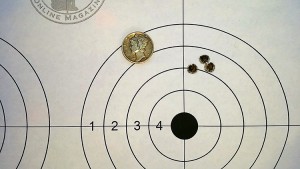 Winchester 35 grain Ballistic SilverTip – 3-Shot Group – 100 Yards
Winchester 35 grain Ballistic SilverTip – 3-Shot Group – 100 Yards
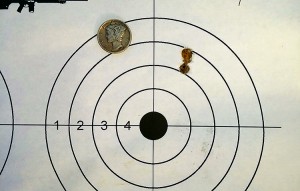
Hornady 35 grain NTX – 3-Shot Group – 100 Yards
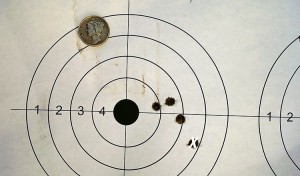
Nosler 40 grain lead-free Ballistic Tip – 3-Shot Group – 100 Yards
All the groups shot at the range were very good, with the final sight-in going to the Winchester 35 grain Ballistic SilverTip rounds. I decided on these for the final sight-in, because they performed very well on some predators and varmints I took last year. They were consistent, and showed how far factory lead free ammunition has come since the early days. After dialing in my rifle, I packed up all my equipment, and bench, then headed out to do some close-in predator hunting (<150 yards).
The Predator Hunt:
The first three stands were blanks, so on my final stand, I decided to switch over to a Predis Maximus hand-call (bottom of the page) made by Reese Outdoors. This is a unique call, with four reeds, that make it loud without much effort. It also sounds really pathetic (a good thing, when you are trying to sound like a dying prey animal) when you mix it up with your cupped hand.
I set-up on the edge of a large farm field, that is bordered by some thick sage and some rolling canyons about 1/4 mile away. I also chose this spot because there are houses about 3 miles away. Coyotes will use these areas as places to hunt the animals on the farm (both wild, and domestic), as well as pets from the housing area. Three miles is not far for a coyote to travel to find a meal, and some of the scat in the area was loaded with cat fur, which was from some the farm owner’s cats that lost their lives.
When I began calling, there was a slight breeze in my face, and no way I could be approached from behind. Within minutes, I caught motion coming from my right, along the berm I was set-up on. This angle gave me no options for a shot. But, when it was around 100 yards out, the wind may have changed, and swirled a little, so it suddenly angled out to the middle of the field! I tried a few more, quiet whimpers, which kept its attention, but it would not come back into the call. It wasn’t running away, but just meandered away from me, stopping to look back every minute, or so. I had my rangefinder handy, so I kept getting readings as it moved farther and farther away. Finally, at 270 yards, I decided it was now, or never. I began whistling, and barking at it, but it kept walking. I then let out a loud, long, “Wooo”, and it stopped. I was following it in my scope, and knew right where to hold with the BDC, because I used the Nikon Spot-On technology on their website to figure out my hold points. I pulled the trigger, and watched the coyote react to the shot in my scope. It spun a couple of times, biting at the hit, then took off running. It went about 75 yards, then dumped in a heap. The little 35 grain bullet hit the mark, and the coyote was dead.
I would normally not shoot this far with such a light bullet, but I knew how it performed at that range, and I knew it would kill the coyote.
I would normally not shoot this far with such a light bullet, but I knew how it performed at that range, and I knew it would kill the coyote. I normally shoot for fur (personal use), unless I am doing depredation work outside of the prime fur season. This coyote had decent fur, so the mange that was showing in the coyotes from this area in years past, was not evident on this coyote. Unfortunately, when I rolled the coyote over, I saw where the bullet had hit something within the body and blew-up while exiting. It left a very large hole, that was tattered and torn in such a way, there was no way to sew it up. It was a very heavy, male coyote, that weighed in at 33.2 pounds. Considering one of the female coyotes I took last year (from the same area) weighed 26.30 pounds, the large size did not surprise me. As stated before, these coyotes are gorging themselves on many domestic animals, along with whatever wild food they can find. This is a problem for anyone living in the area, especially the farmers who lose farm cats, chickens, goats and other livestock to the opportunistic coyotes.
I carried the coyote back to an area where I could roll some video, and discuss the shot. I also took a much closer look at the wound, and saw that the bullet barely clipped one of the ribs, causing the blow-up. Afterwards, I removed the skull and some of the claws, and left it in an area that was loaded with Ravens. I knew they (and other predators) would devour the left-over carcass within days.
Final Thoughts:
We are starting to reap the rewards of more bullet makers entering the market, with more accurate factory ammunition, and better bullet performance. Although I was disappointed in the performance of this bullet, I would typically shy away from a ballistic type bullet, for larger coyotes, out of a .223. The problem is, going lead free means testing various loads to find what works well in your rifle, THEN testing them on the game you are hunting. It is usually the other way around, where you can pick the bullet you want to use on the game, then buy one of the various factory loads available. Also, if you reload, the choices of bullet types/weights, are numerous. The bullets I used in this hunt are excellent for smaller varmints, but I would recommend heavier bullets for coyote sized game. We have lots of video of these bullets performing very well on smaller varmints. As we review more factory lead free ammunition, we will move up to heavier bullets in the 50 to 55 grain range, and other bullets that will perform in standard twist, factory rifles.

